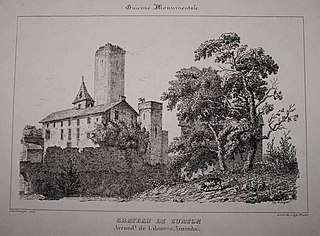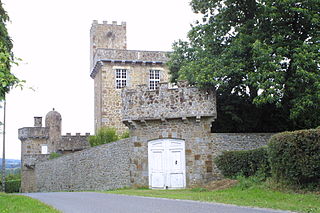
The House of Albret, which derives its name from the lordship (seigneurie) of Albret (Labrit), situated in the Landes, was one of the most powerful feudal families of France and Navarre during the Middle Ages.

The arrondissement of Langon is an arrondissement of France in the Gironde department in the Nouvelle-Aquitaine region. It has 195 communes. Its population is 134,250 (2021), and its area is 2,644.3 km2 (1,021.0 sq mi).

The Archdiocese of Bordeaux (–Bazas) is a Latin Church ecclesiastical territory or archdiocese of the Catholic Church in France. The episcopal see is Bordeaux, Aquitaine. It was established under the Concordat of 1802 by combining the ancient Diocese of Bordeaux with the greater part of the suppressed Diocese of Bazas. The Archdiocese of Bordeaux is a metropolitan see, with four suffragan dioceses in its ecclesiastical province: Dioceses of Agen, Aire and Dax, Bayonne, and Périgueux.

The Diocese of Fréjus–Toulon is a Latin diocese of the Catholic Church in southeastern France on the Mediterranean coast. The present diocese comprises the territory of the ancient Diocese of Fréjus as well as that of the ancient Diocese of Toulon. In 1957 it was renamed as the Diocese of Fréjus–Toulon.

The Diocese of Périgueux and Sarlat is a Latin Church ecclesiastical territory or diocese of the Catholic Church in France. Its episcopal see is Périgueux, in the département of Dordogne, in the région of Aquitaine. The Diocese of Périgueux is a suffragan diocese in the ecclesiastical province of the metropolitan Archdiocese of Bordeaux. The current bishop is Philippe Mousset, who was appointed in 2014.

The Bishopric of Lodève is a former Roman Catholic diocese in southern France. Its episcopal see was located in Lodève, in the modern department of Hérault. Its territory is now part of the archdiocese of Montpellier.

The Metropolitan Archdiocese of Montpellier (–Lodève–Béziers–Agde–Saint-Pons-de-Thomières) is a Latin archdiocese of the Catholic Church in south-western France. The current metropolitan archbishop is Pierre-Marie Carré; the immediate past Archbishop Emeritus is Guy Marie Alexandre Thomazeau. On September 16, 2002, as part of the reshuffling of the map of the French ecclesiastical provinces, the diocese of Montpellier ceased to be a suffragan of Avignon and was elevated to archdiocese and metropolitan of a new ecclesiastical province, with the dioceses of Carcassonne, Mende, Nimes and Perpignan–Elne as suffragans.

The Diocese of Valence (–Die–Saint-Paul-Trois-Châteaux) (Latin: Dioecesis Valentinensis ; French: Diocèse de Valence is a Latin Church diocese of the Catholic Church in southern France. The contemporary diocese is co-extensive with the department of Drôme.

The Diocese of Bazas, centred on Bazas in Aquitaine, covered the Bazadais region, known under the Romans as the Vasatensis pagus after the ancient occupants, the Vasates. In the 2nd century it was part of the Novempopulania, one of the seventeen provinces of Gaul. The diocese must have been created between the first and the third centuries, but because of the large numbers of invaders that passed through this region - Arians, Saracens, Normans - the list of bishops is much reduced during the first millennium. The first bishop of this diocese is mentioned, without a name, by Gregory of Tours in his De gloria martyrum.

The former Catholic Diocese of Lectoure was in south-west France. It existed from the fourth century until the time of the French Revolution, when it was suppressed under the Concordat of 1801. Its see was Lectoure Cathedral. Lectoure is now a commune of Gers.

The Diocese of Carcassonne and Narbonne is a Latin Church ecclesiastical jurisdiction or diocese of the Catholic Church in France. The diocese comprises the entire department of Aude. It is suffragan to the Archdiocese of Montpellier.

Château de Curton is a castle located in the commune of Daignac in the department of Gironde. It is situated on the edge of the town of Tizac-de-Curton, which takes its name from the first seigneurs (lords) of Curton. It is a Bordeaux winery in the Entre-Deux-Mers wine region producing wines classified as Bordeaux AOC.

Sainte-Honorine-la-Guillaume is a commune in the Orne department in north-western France.
The Friends of Man are a Christian denomination founded in 1919 by Frédéric-Louis-Alexandre Freytag, the former Branch manager of the Swiss Watch Tower Society since 1912. He founded a group first named the Angel of the Lord, Angel of Jehovah Bible and Tract Society, then Church of the Kingdom of God or the Philanthropic Assembly of the Friends of Man.
Amanieu VI was a French nobleman, the Lord of Albret. The lordship (seigneurie) of Albret, in the Landes, gave its name to one of the most powerful feudal families of France in the Middle Ages. One of Amanieu’s descendants became king of Navarre; a later descendant was Henry IV, king of France.
Pierre Jacques Dormoy was a French engineer, inventor, industry captain, the creator of the Dormoy foundries as well as a political and economic personality in Bordeaux. His political activities in Bordeaux were instrumental in arousing the political vocation of his son, Albert Dormoy, an MP for the Gironde département.

Hugh de Vivonne was a French knight from Vivonne in the County of Poitou. He was loyal to the Plantagenet family and supported their right to vast lands in France. From 1215 onward he made his home in England, where he was constable of Bristol Castle and later High Sheriff of Somerset and Dorset (1241–49). He married an English lady and became lord of Chewton and Curry Mallet. He received further English estates in compensation for the loss of his lands in France. Yet, as a foreign soldier in the king's pay, he has been described as merely a "Poitevin mercenary captain".
Rostan de Soler was a 13th-century French knight and administrator who served as lieutenant of the Seneschal of Gascony in 1231 and then Seneschal of Gascony 1241–43. During his seneschalcy, King Henry III of England, who was also the hereditary Duke of Aquitaine and Gascony, launched the a war against France. One of the lead citizens (prud'hommes) of Bordeaux, he served two terms as mayor there in 1237–38 and 1241.
Guillaume Cureau was a French painter.















